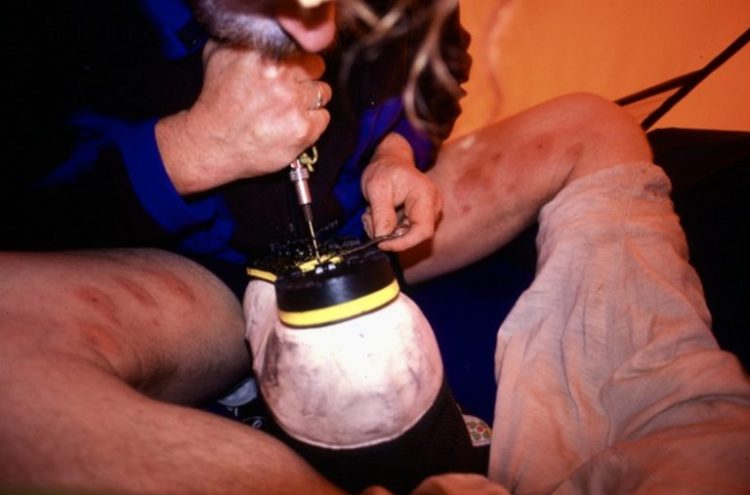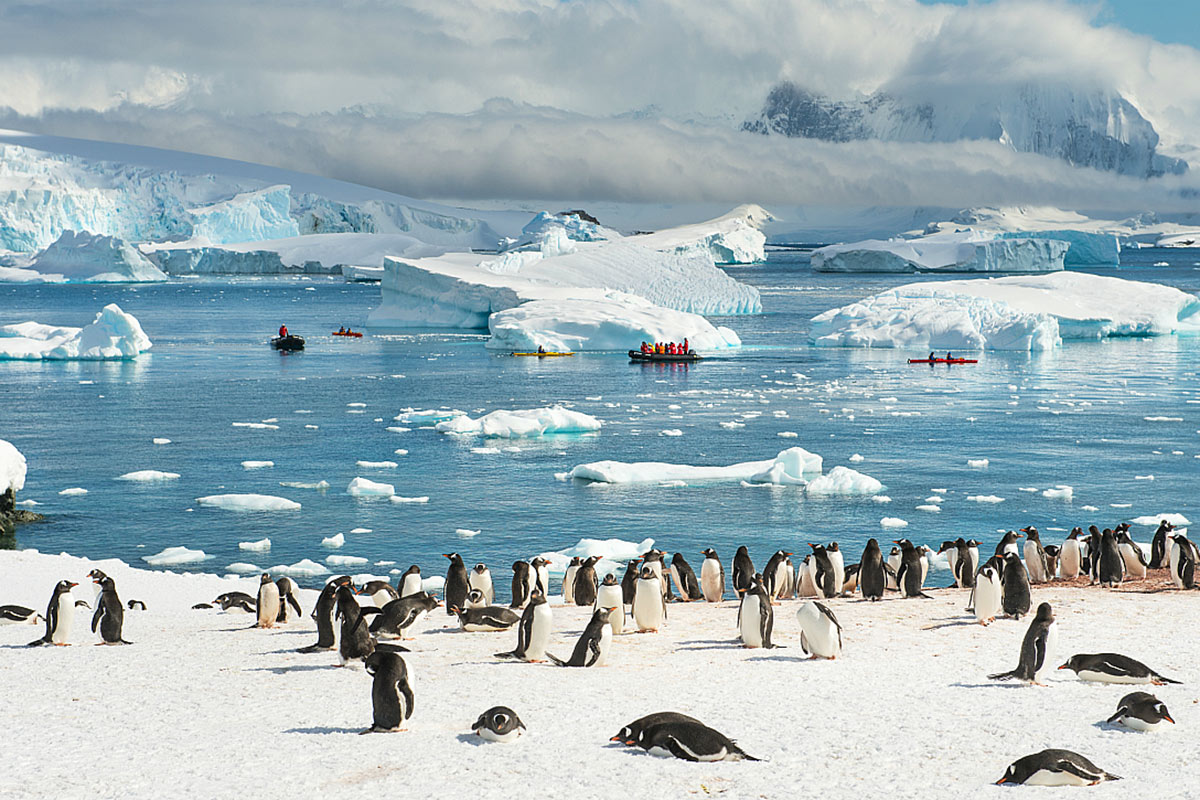In recent years, Instagram has been filled with “gory” photos showing what travelers have had to endure in Antarctica. The victims are often, although not always, women. What is this mysterious illness that befalls many travelers in Antarctica?
In truth, it is not only about chafing of the skin. If famous polar explorers of the past suffered from such a terrible illness, they would have certainly mentioned it somewhere, despite all their harsh nature.
What is this illness? And why Antarctica? Many people ski in Greenland and other places in the far north and don’t seem to have any problems with it.
I’ve been on many sledding expeditions to the Arctic and neither I nor my partners have ever had this condition. Or maybe I was wearing light clothing and didn’t realize it. On most of these expeditions I used synthetic thermal underwear. After sheepskin became popular, I tried it on colder trips because sheepskin is much warmer than synthetics of the same thickness. After two or three weeks, a rash started to appear on my legs. Then I switched to spare synthetic underwear and the rash went away. This happened on two expeditions.
I think the first time I saw a real “polar hip” was when two Australians, James Castrission and Justin Jones (Cass and Jonesy), made a three-month trek to Antarctica in 2011-12. They filmed it in their fascinating film, “Crossing the Ice.” One of them developed a bleeding and festering ulcer on his thigh, which he showed in his film.

Sheep’s wool for three months
The Australians were wearing merino wool (a breed of fine-wool sheep), and given my own limited experience with leg rash caused by merino wool, I assumed it was because they had been wearing wool underwear for three months. They probably didn’t have any synthetic pads, or, as novice polar explorers, they didn’t associate the ailment with their underwear. Merino wool is very comfortable, but few people have worn long underwear for two or three months without taking it off, so we can know whether the salt or bacterial buildup in this natural fiber causes skin irritation that could worsen the condition of polar explorers.
To get a better understanding, I interviewed many polar explorers and guides, including Borge Ousland, Richard Weber, Erik Larsen, Erik Philips, Erik Boomer, and Lars Ebbesen. Not everyone agreed, but two theories emerged: that it had something to do with the wool, and that it was some kind of infected frostbite.

Weber wears only synthetics
Polar guide Richard Weber is one of the proponents of the wool-bad-underwear theory, and has long insisted that his clients wear only synthetics.
“I believe it’s due to wool underwear, which doesn’t breathe well, combined with waterproof/breathable jackets in cold weather,” he says. “I suspect it’s just bacteria going crazy.”
He adds: “I’ve never had this happen to me because I’ve always worn thin synthetic underwear and breathable jackets.
Weber says that on his last trip to the South Pole, one of his clients wore wool, against his strict instructions. “She started having this ‘hip problem’, she went straight to synthetics and it went away,” he said.
Larsen: Antarctica is warmer and windier
Erik Larsen agrees with Weber. “I was a guide on my first trip to the South Pole in 2008, and”We talked about it then,” he said. “It’s definitely more of an Antarctic phenomenon than an Arctic phenomenon. I think it’s because it’s warmer and windier in Antarctica.”
Larsen believes wool may be a risk factor not because of friction or chafing, but because wool doesn’t wick moisture away from the skin the way synthetics do. Like Weber, Larsen always wears synthetic baselayers and has also never suffered from the condition.
“In my opinion,” Larsen adds, “the mechanism for polar hip is that your hips get too cold, but you barely notice it. Then you get some kind of cold damage, like skin irritation from the cold and the wool. This is made worse if the skin is damp because there’s poor ventilation and no wicking. As your skin gets damaged, it starts to itch, you scratch it more, and it gets infected. The more you sweat on a hike, the more dirty and frostbitten your skin gets…”
“It happens more in Antarctica because it’s much windier and you’re basically skiing into a headwind the whole time.”
Being overweight
Eric Phillips believes that merino wool can contribute to polar hip, but admits he’s not sure. “I’ve had clients with polar hip, and my daughter has it too,” Phillips says. “It seems to be more common in women and people with a higher percentage of body fat.”
Phillips recalls that John Muir, one of his partners on the 1998 South Pole expedition, had a mild form of the condition. “John definitely wore wool,” he said.

Borge Ousland also got polar hip disease during one of his first expeditions to the South Pole in 1995.
“It was probably caused by chafing, which then became infected,” Ousland said. “But I think most of the time it starts with frostbite, which turns into a wound and eventually gets infected. When I started wearing longer, warmer underwear, trying to avoid chafing at the seams, I didn’t get that. My theory is that the thighs are well insulated with fat and few blood vessels, allowing the skin to retain heat, and it’s easy to get minor local frostbite there.”

Lars Ebbesen, manager of a polar gear company in Ousland, is no stranger to “polar hip.”
“It’s frostbite, pure and simple,” insists Ebbesen. “It shows up on your legs in places where the circulation is poor. On the inside, for example.”
He admits that it looks like a normal red rash at first, but it’s almost always the beginning of frostbite.
“And that’s where things often go wrong,” he warns. “If you don’t take immediate precautions and just think that the rash is the only way out, you’ll lose precious time trying to stop frostbite. It will only get worse and there will be no turning back.”
Lars Ebbesen says that at the first sign of a rash, a traveler should immediately protect the affected area by warming it up or even wearing down pants. If the rash is allowed to progress too far, it can become an open wound.

Advanced polar hip disease won’t heal in the cold
“Once it gets to that point, it’s extremely difficult to heal in the cold,” Ebbesen says. “Usually the wound just keeps growing. Even though places like Antarctica are the most pristine and clean in the world, you still run the risk of infection. So antibiotics can be life-saving.”
Given the potential for delays in treatment, the condition — if it’s so advanced that the infection gets into the bloodstream — can be fatal, he says. It’s dangerous even after an expedition ends and the traveler returns to warmer conditions. Circulation improves, and infection can spread quickly.
To prevent polar hip disease, “we don’t let anyone on the ice without shorts or pants made of synthetic material,” says Ebbesen. He notes that many polar explorers, both men and women, now wear short skirts to protect their thighs from the icy wind. Norwegians, he says, often wear an extra layer of special thermal underwear under their long johns to trap air and retain heat, but at the same time wick away moisture.

Erik Larsen agrees with this precaution: “I also wear long cut-off shorts – an extra pair of lightweight long underwear cut off at the knee,” he says.
Those who sweat a lot have it tougher.
Another important point: we all react differently to the cold. At -35°C, my wife’s face really hurts, but I’m perfectly comfortable. (This is the main reason we’ve done so many canoeing and bike tours together, but never sledded.) I barely sweat when pulling a sled, while some of my sled partners sweat profusely. People who sweat a lot are always on the edge between freezing and exhausted. For others, the difference between the two extremes is quite wide.
My bottom layers are changed much less frequently than my top layers, because I have to take my boots and skis on and off. I almost never change my bottom layers during the day – it doesn’t matter if I’m a little hot there, because I hardly sweat – but I sometimes adjust my top layers, hat and gloves several times an hour.
Eric Boomer admits that he sweats a lot.
“I really need to air out and change layers often,” Boomer says. “My knees, thighs, and part of my chest get cold, and these are areas to watch out for, especially on cold, windy days.”
When he first went winter hiking on Baffin Island, he didn’t wear enough clothing on his legs.
Conclusion
Whether it’s wool, excessive sweating, infected frostbite, or a condition like cold panniculitis, polar hip is preventable:
While not everyone believes that wool is a factor in the condition, if you want to be on the safe side, wear synthetic underwear. Or at least have some as a backup so you can change at the first sign of a rash.
To combat Antarctica’s unique combination of summer heat and icy winds, wear a down or synthetic skirt or an extra pair of knee-length synthetic baselayers. At the first sign of a rash, take action—improving moisture control, wearing warmer layers, changing clothes—before they become so contaminated that they can lead to a skin infection.
Author of the article: Jerry Kobalenko (Jerry Kobalenko)
Jerry Kobalenko is one of Canada’s leading Arctic explorers, author of the books “Horizontal Everest” and “Arctic”Cheshka Eden”. In 2018, the Governor General of Canada awarded him the Polar Medal, and in 2022 he received the Queen’s Platinum Jubilee Medal for services to Arctic exploration.
Material prepared by: alp.org.ua

